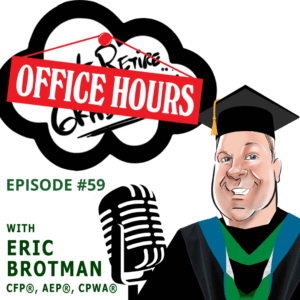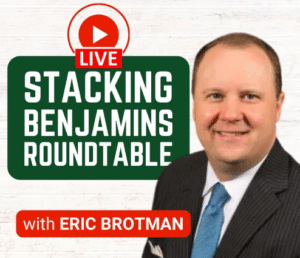In today’s Office Hours, Eric answers Ryan’s question: “When and how do you come with a hard figure goal for your retirement savings?”
Setting a savings goal for retirement is trying to hit a moving target, so you should be revisiting this question regularly. But if you’re trying to do the math, this episode can help.
Have a question? Post it in the comments, tweet it to us at @BrotmanPlanning, or post it on our Facebook and it may be used in a future episode of Office Hours!
[00:00:00] Eric Brotman: This is Eric Brotman, the host of Don’t Retire… Graduate!: The podcast that teaches you how to advance into retirement rather than retreating. Welcome to office hours where we answer listeners’ questions about personal finance, retirement readiness, and more. We received a question from Ryan who asked, “when and how do you come up with a hard figure goal for your retirement saving?”
Ryan, this is one of those things that that companies and marketing departments and advertisers have tried to hit on. This point that there’s a number. What is your number? And the idea that there is a set number after which you’re good. It’s an important concept and it can work, but in most cases it’s a moving target.
So if you’re 35 years old and you’re looking at what your number’s going to be at 65 years old, first of all, the number’s gonna look obscenely large because you are going to have 30 years of inflation and presumably some cost of living increases and, and some income increases and, and all those various things.
And so the number’s gonna look obscenely big in order to reach financial independence. And, you know, we’ve done shows and answered questions about withdrawal rates in the past and this is one of those where your, your nest egg has to be a multiple of the, the dollars you need in a given year in order to make this work.
So it’ll look like a huge number. The challenge is that even though a time value of money problem, and that’s all this is, this is basic math. A time value of money problem will give you a correct mathematical answer, but the output will be absolutely wrong. And here’s what I mean by that. You have to include some assumptions.
For that 35 year old looking ahead 30 years to a potential retirement or financial independence age or financial freedom, when you look to do that, there are some assumptions that have to be made. Assumptions about investment returns. Assumptions about career earnings. Assumptions about inflation and the cost of living. Assumptions about your life. and all of them will be wrong, even if they’re reasonable, even if they’re averages, they will be wrong.
So what’s important here is to not only have that, that goal, that number in mind, but also to at least annually look at where you are and make sure that that number is still an appropriate number for you. Is it still the right figure? Has something changed in your life that will change that? Has there been a job change? Have you had triplets? Did you get married or divorced? Did you inherit money from someplace? All the various things that are gonna play into this that you can’t possibly plan for or guess in advance will impact that number. So yes, you can come up with a hard figure as, as you stated for your retirement savings.
And I can tell you today what that number is, and I can also tell you that tomorrow it won’t be the number anymore. And so it’s important not to do this once and stick it on a shelf in a, in a binder and forget it. It’s important to look at this every year because it is a moving target. And I hope that resonates because if, if you set a goal when you’re 35 and you never adjust it, Even if you hit the target to the penny that you anticipated, it may not provide the outcome that you were looking for.
So Ryan, you asked when and how do you come up with it? The when is you can do it today. It is a time value of, of money problem. And it’s something a financial advisor can do for you very, very easily and very quickly. And the how is if you’re either gonna hire somebody to do this, or you’re gonna use a software package or do this on your own.
And you’re basically gonna say there are two ways that you’re growing your nest egg. One of ’em is what do you have currently and what will it grow to become? So if you have a hundred thousand dollars in an account somewhere, and it’s gonna earn 6% for the next 30 years, you can calculate what that is. And of course these numbers, I’m making them up, but you can calculate what that number would be, but then you also have to calculate the number that if you are adding to that account, let’s say you’re adding $10,000 a year to that account for the next 30 years.
And you get the same interest, same rate of return on it. What will that grow to be? And then you take the, the value of the existing money. You add it to the value of the new money or the annual deposits. You come up with a total and that’s the number you’ve amassed. Then you have to figure out is that number enough to create as close to a hundred percent of your pre-retirement income as possible with a withdrawal rate no greater than 4%. And if this sounds like simple math, go for it. If this sounds like maybe something you’d like some help with, get some assistance, call your financial advisor or, or or contact a firm like ours that can help figure that out for you, but then understand you’re gonna want to do that regularly.
Not every week, but once a year, at least you should, you should refigure that and say, how have we done? What has inflation been? Did we get a raise? Are we now putting away 15,000 a year instead of 10? What was the rate of return? Did we lose 7% that year? Or did we gain 7% that year? And every year you can adjust the trajectory.
It will not be linear. So I hope that helps. When is anytime, how is either on your own or with a financial advisor and, and, and I would tell you to do it regularly annually would be best. Thank you for your question, Ryan. I do appreciate it. If you’d like to send us a question which we might answer in a future episode of office hours, post it on our Facebook page, or tweet us at @BrotmanPlanning.
If you like, what you hear, please subscribe to our podcast and leave a rating on Spotify or wherever you listen to your favorite shows. Please also check out our books, workbooks and online financial literacy resources at brotmanmedia.com. Thanks for coming to office hours. Be sure to tune in for new content every Thursday for now, this is your host, Eric Brotman reminding you don’t retire. Graduate.
[00:05:40] Narrator: Securities offered through Kestra investment services, LLC. Kestra IS. Member FINRA SIPC. Investment advisory services offered through Kestra Advisory Services LLC. Kestra AS.. An affiliate of Kestra IS. Kestra IS or Kestra AS are not affiliated with Brotman financial or any other entity discussed.







